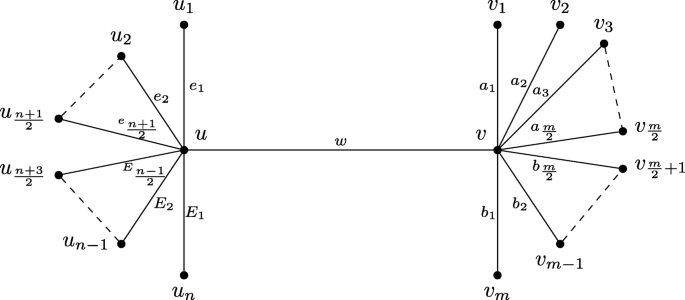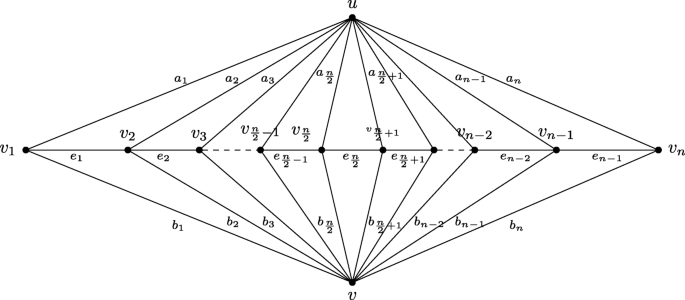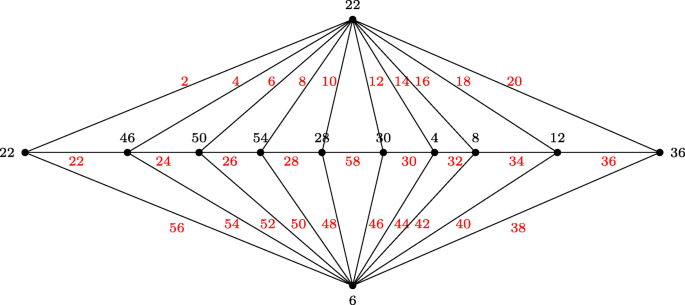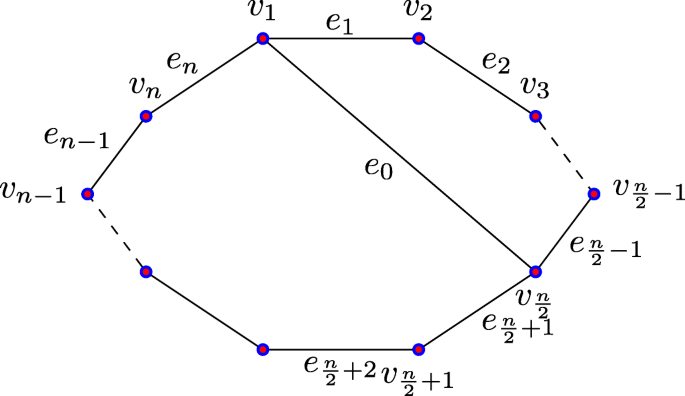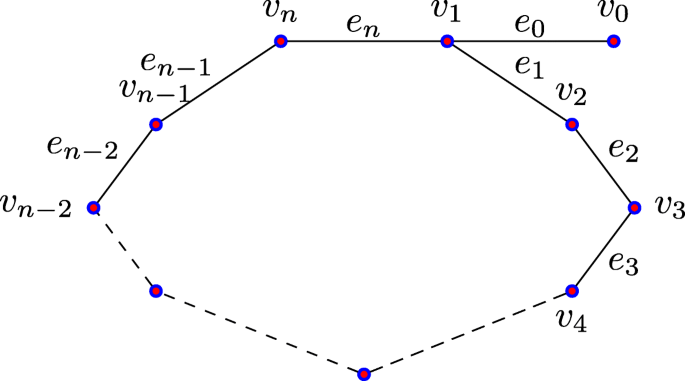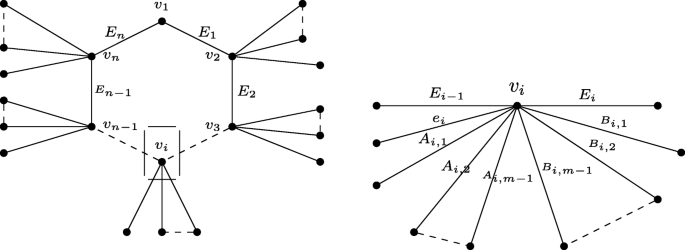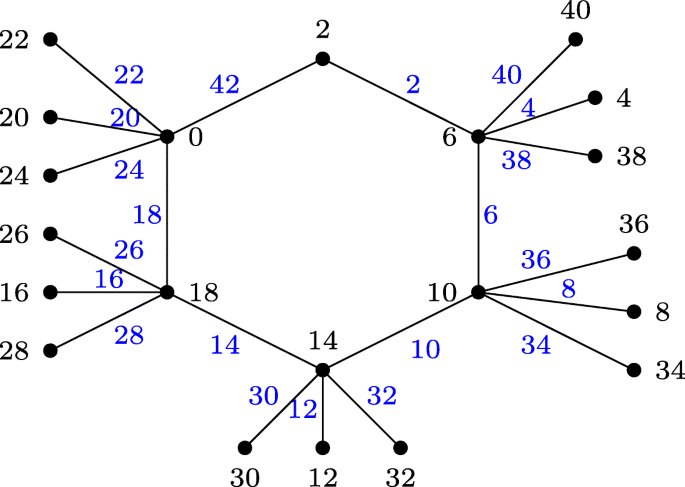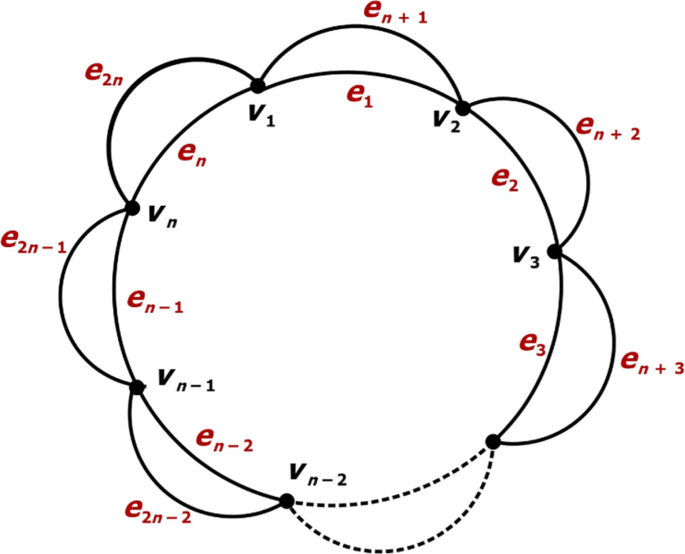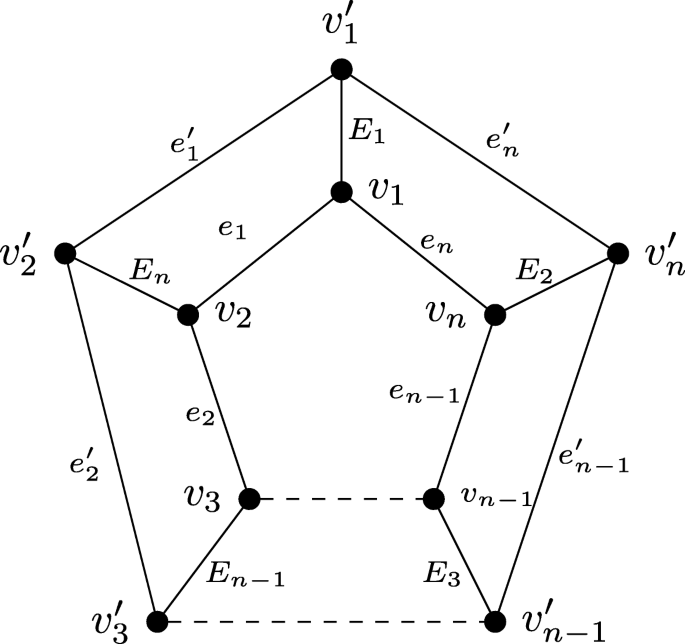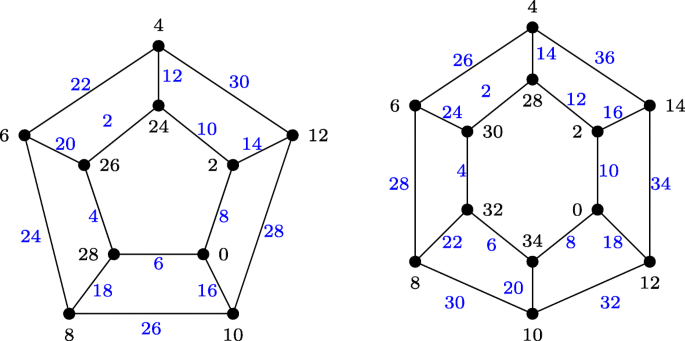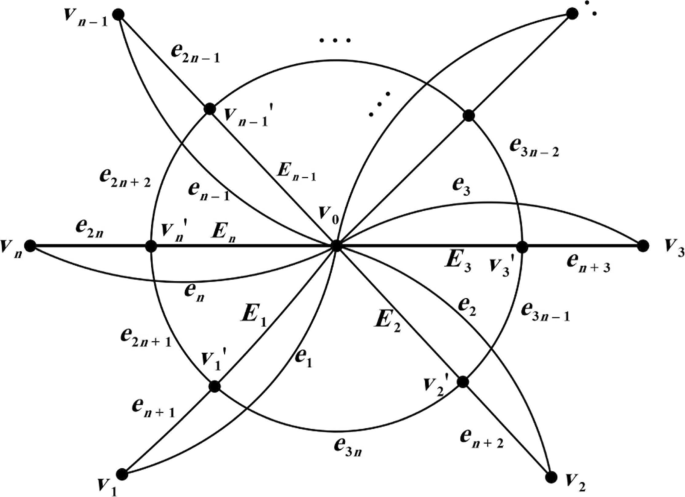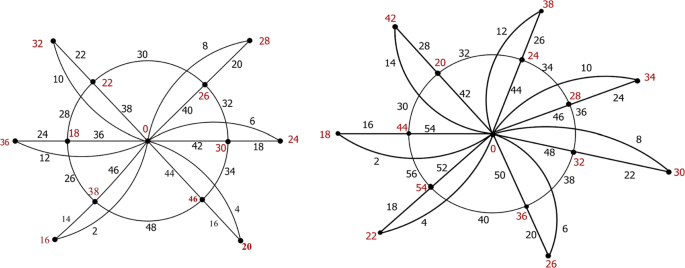- Original research
- Open access
- Published:
Edge even graceful labeling of some graphs
Journal of the Egyptian Mathematical Society volume 27, Article number: 20 (2019)
Abstract
Edge even graceful labeling is a new type of labeling since it was introduced in 2017 by Elsonbaty and Daoud (Ars Combinatoria 130:79–96, 2017). In this paper, we obtained an edge even graceful labeling for some path-related graphs like Y- tree, the double star Bn,m, the graph 〈K1,2n:K1,2m〉, the graph \( ~P_{2n-1}\odot \overline { K_{2m}}~ \), and double fan graph F2,n. Also, we showed that some cycle-related graphs like the prism graph \( ~\prod _{n}~ \), the graph \( ~C_{n}\left (\frac {n}{2}\right)~ \), the flag FLn, the graph K2⊙Cn, the flower graph FL(n), and the double cycle {Cn,n} are edge even graphs.
Introduction
A graph labeling is an assignment of integers to the edges or vertices, or both, subject to certain condition. The idea of graph labelings was introduced by Rosa in [1]. Following this paper, other studies on different types of labelings (Odd graceful, Chordal graceful, Harmonious, edge odd graceful) introduced by many others [2–4]. A new type of labeling of a graph called an edge even graceful labeling has been introduced by Elsonbaty and Daoud [5]. They introduced some path- and cycle-related graphs which are edge even graceful.
Graph labelings give us useful models for a wide range of applications such as coding theory, X-ray, astronomy, radar, and communication network addressing.
Definition 1
[5] An edge even graceful labeling of a graph G(V(G), E(G)) with p=|V(G)| vertices and q=|E(G)| edges is a bijective mapping f of the edge set E(G) into the set {2,4,6, ⋯,2q } such that the induced mapping f∗:V(G) →{0,2,4,⋯,2q }, given by: \( f^{\ast }(x) = \left ({\sum \nolimits }_{xy \in E(G)} f(xy)~ \right)~mod~(2k) \), is an injective function, where k=max(p,q). The graph that admits an edge even graceful labeling is called an edge even graceful graph.
In Fig. 1, we present an edge even graceful labeling of the Peterson graph and the complete graph K5.
Edge even graceful for some path related graphs
A Y- tree is a graph obtained from a path by appending an edge to a vertex of a path adjacent to an end point, and it is denoted by Yn where n is the number of vertices in the tree.
Lemma 1
The Y-tree Yn is an edge even graceful graph when n is odd.
Proof
The number of vertices of Y-tree Yn is n and the number of edges is n−1. Let the vertices and the edges of Yn be given as in Fig. 2.
We define the mapping f:E(Yn) →{2,4,⋯,2n−2} as follows:
Then, the induced vertex labels are
Similarly, \( ~~~f^{\ast }\left (v_{\frac {n+3}{2}}\right)= 6~,~~~~~~~~~~~~~ f^{\ast }\left (v_{\frac {n+5}{2}}\right)= 8~, f^{\ast }\left (v_{\frac {n+7}{2}}\right)= 10 ~\),
Clearly, all the vertex labels are even and distinct. Thus, Y-tree Yn is an edge even graceful graph when n is odd. □
Illustration: The edge even labeling of the graph Y13 is shown in Fig. 3.
Double star is the graph obtained by joining the center of the two stars K1,n and K1,m with an edge, denoted by Bn,m. The graph Bn,m has p=n+m+2 and q=n+m+1.
Lemma 2
The double star Bn,m is edge even graceful graph when one (m or n) is an odd number and the other is an even number.
Proof
Without loss of generality, assume that n is odd and m is even. Let the vertex and edge symbols be given as in Fig. 4.
Define the mapping f:E(Bm,n) →{2,4,⋯,2q} as follows:
We realize the following:
So, the vertex labels will be
Also, each pendant vertex takes the labels of its incident edge which are different from the labels of the vertices U and v. □
The graph 〈K1,n:K1,m〉 is obtained by joining the center v1 of the star K1,n and the center v2 of the another star K1,m to a new vertex u, so the number of vertices is p=n+m+3 and the number of edges is q=n+m+2.
Lemma 3
The graph 〈K1,2n:K1,2m〉 is an edge even graceful graph.
Proof
Let the vertex and edge symbols be given as in Fig. 5.
Define the mapping f:E(G) →{2,4,⋯,2p} as follows:
We can see the following:
So, the vertex labels will be
which are even and distinct from each pendant vertices. Thus, the graph 〈K1,2n:K1,2m〉 is an edge even graceful graph. □
Lemma 4
The corona [6]\( ~P_{3}\odot \overline { K_{2m}}~ \) is an edge even graceful graph.
Proof
In this graph p=6m+3 and q=6m+2. Let the vertex and edge symbols be given as in Fig. 6.
We can define the mapping \(f: E(P_{3}\odot \overline { K_{2m}}~)~\rightarrow \{2,4,\cdots, 2q \}\) as follows:
It is clear that f(Aij)+f(Bij)≡0 mod (2p) for j=1,2,⋯,m
So the vertex labels will be,
Therefore, all the vertices are even and distinct which complete the proof. □
Illustration: The edge even labeling of the graph \( ~P_{3}\odot \overline { K_{6}}~ \) is shown in Fig. 7.
The generalization of the previous result is presented in the following theory
Theorem 1
The graph \( ~P_{2n-1}\odot \overline { K_{2m}}~ \) is an edge even graceful graph.
Proof
In this graph, p=4nm+2(n−m)−1 and q=4nm+2(n−m)−2. The middle vertex in the path P2n−1 will be vn, and we start the labeling from this vertex. Let the vertex and edge symbols be given as in Fig. 8.
Define the mapping f:E(G) →{2,4,⋯,2q} by the following arrangement
f(ei)=2i for i=1,2,⋯,n−1
f(bi)=2p− 2i for i=1,2,⋯,n−1
f(Aij) will take any number from the reminder set of the labeling not contains 2i nor 2p− 2i for j=1,2,⋯,m and
f(Dij)=2p−[f(Aij)] for j=1,2,⋯,m.
It is clear that [f(Aij)+f(Dij)] mod (2p)≡0 mod (2p) for j=1,2,⋯,m.
So, the vertex labels will be
f∗(vn)=[f(e1)+f(b1)] mod (2p) ≡0 mod (2p),
For any vertex vk when k<n, let k=n−i and i=1,2,⋯,n−2
When k>n, let k=n+i and i=1,2,⋯,n−2
The pendant vertices v1 and v2n−1 of the path P2n−1 will take the labels of its pendant edges of P2n−1,i.e.,
If n is even, then f∗(v1)=f(en−1), and f∗(v2n−1)=f(bn−1)
If n is odd, then f∗(v1)=f(bn−1), and f∗(v2n−1)=f(en−1)
Then, the labels of the vertices of the path P2n−1 takes the labels of the edges of the path P2n−1, and each pendant vertex takes the labels of its incident edge. Then, there are no repeated vertex labels, which complete the proof. □
Illustration: The graph \( ~P_{11}\odot \overline { K_{4}}~ \) labeled according to Theorem 1 is presented in Fig. 9.
A double fan graph F2,n is defined as the graph join \(\overline {K_{2}} + P_{n}~\) where \(\overline {K_{2}} \) is the empty graph on two vertices and Pn be a path of length n.
Theorem 2
The double fan graph F2,n is an edge even graceful labeling when n is even.
Proof
In the graph F2,n we have p=n+2 and q=3n−1. Let the graph F2,n be given as indicated in Fig. 10.
Define the edge labeling function f:E(F2,n)→ {2,4,⋯, 6n−2} as follows:
f(ai)=2i; i=1,2,⋯n
f(bi)=2q−2i=6n−2(i+1); i=1,2,⋯n
Hence, the induced vertex labels are
\(~ f^{\ast }(u) = \left (\sum _{i=1}^{n}(f(a_{i}))\right)~\text {mod}(6n-2)\,=\, \left (\sum _{i=1}^{n}(2i)\right)~\text {mod}(6n-2) =(n^{2}+n)~\text {mod}(6n-2)~~\)
\(~ f^{\ast }(v) = \left (\sum _{i=1}^{n}(f(b_{i})) \right)~\text {mod}(6n-2)= \left (\sum _{i=1}^{n}(2q-2i)\right)~\text {mod}(6n-2) =\left (- n^{2}-n\right)~\text {mod}(6n-2) \)
\( f^{\ast }(v_{i}) \,=\, \left [\sum _{i=1}^{n}(f(a_{i})\,+\,f(b_{i})\,+\,f (e_{i}) \,+\,f(e_{i-1}))\right ]~\text {mod}(6n\,-\,2)~ \,=\,(4n\,+\,4i\,-\,2)~\text {mod}(6n\,-\,2)~,~~2 \leq i \leq \frac {n}{2}- 1 \)
\(f^{\ast }(v_{i}) = \left [\sum _{i=1}^{n}(f(a_{i})+f(b_{i})+f (e_{i}) +f(e_{i-1}))\right ]~\text {mod}(6n-2) =(4n+4i-6)~\text {mod}(6n-2),~~\frac {n}{2}+2 \leq i \leq n- 1 \)
Since [f(ai)+f(bi)] mod(6n−2)=0, we see that
f∗(v1)= f(e1)=2n+2,
f∗(vn)= f(en−1)=4n−4,
\(~~~~~ f^{\ast }(v_{\frac {n}{2}})=~f (e_{\frac {n}{2}-1})= 3n-2 ~\) and
\( ~~~~f^{\ast }(v_{\frac {n}{2}+1})=~f (e_{\frac {n}{2}})= 3n ~\)
Thus, the set of vertices \( v_{1}, v_{2},v_{3},\cdots ~,v_{\frac {n}{2}-1},v_{\frac {n}{2} },v_{\frac {n}{2}+1},v_{\frac {n}{2}+2},v_{\frac {n}{2}+3},\cdots ~,v_{n-2},v_{n-1},v_{n} \) are labeled by 2n+2, 4n+6, 4n+10,⋯,6n−6, 3n−2, 3n, 4,8, ⋯,2n−12, 2n−8, 4n−4 respectively.
Clearly, f∗(u) and f∗(v) are different from all the labels of the vertices. Hence F2,n is an edge even graceful when n is even. □
Illustration: The double fan F2,10 labeled according to Theorem 2 is presented in Fig. 11.
Edge even graceful for some cycle related graphs
Definition 2
For n≥4, a cycle (of order n) with one chord is a simple graph obtained from an n-cycle by adding a chord. Let the n-cycle be v1v2⋯vnv1. Without loss of generality, we assume that the chord joins v1 with any one vi, where 3≤i≤n−1. This graph is denoted by Cn(i).
Lemma 5
The graph \( ~C_{n}\left (\frac {n}{2}\right)~ \) is an edge even graceful graph if n is even.
Proof
Let \( \{ v_{1}, v_{2},\cdots, v_{\frac {n}{2}-1},v_{\frac {n}{2}},v_{\frac {n}{2}+1}, \cdots,v_{n} \}\) be the vertices of the graph \(C_{n}\left (\frac {n}{2}\right)\), and the edges are ei=(vivi+1) for i≤i≤n−1 and the chord \(e_{0}=(v_{1}v_{\frac {n}{2}}) \) connecting the vertex v1 with \(v_{\frac {n}{2}}\) as in Fig. 12.
Here, p=n and q=n+1, so 2k=2q=2n+2; first, we label the edges as follows:
Then, the induced vertex labels are as follows:
for any other vertex \(~~~v_{i}, ~~~i\neq 1,\frac {n}{2}\)
Hence, the labels of the vertices \(v_{0}, v_{1},v_{2}, \cdots,v_{\frac {n}{2}-1},v_{\frac {n}{2}},v_{\frac {n}{2}+1}, \cdots v_{n} \) are 6, 10, 14,⋯, 2n−2, 2, 4,⋯, 2n respectively, which are even and distinct. So, the graph \( ~C_{n}\left (\frac {n}{2}\right)~ \) is an edge even graceful graph if n is even. □
Definition 3
Let Cn denote the cycle of length n. The flag FLn is obtained by joining one vertex of Cn to an extra vertex called the root, in this graph p=q=n+1.
Lemma 6
The flag graph FLn is edge even graceful graph when n is even.
Proof
Let {v1,v2,⋯,vn} be the vertices of the cycle Cn and the edges are ei=(vivi+1) for 1≤i≤n and the edge e=(v1v0) connecting the vertex v1 with v0 as in Fig. 13.
First, we label the edges as follows:
Then, the induced vertex labels are as follows f∗(v0)=f(e0)=2,
Hence, the labels of the vertices \(v_{0}, v_{1},v_{2}, \cdots,v_{\frac {n}{2}-1},v_{\frac {n}{2}},v_{\frac {n}{2}+1}, \cdots v_{n} \) will be 2, 6, 10, 14,⋯, 2n−2, 0, 4,⋯, 2n respectively. □
Lemma 7
The graph K2⊙Cn is edge even graceful graph when n is odd.
Proof
Let \( \left \{ v_{1}, v_{2},\cdots, v_{n},v^{'}_{1},v^{'}_{2}, \cdots,v^{'}_{n} \right \}\) be the vertices of the graph K2⊙Cn and the edges are \( \left \{e_{1}, e_{2},\cdots, e_{n},~e^{'}_{1},e^{'}_{2}, \cdots,e^{'}_{n} \right \}\) as shown in Fig. 14. Here, p=2n and q=2n+1, so 2k=4n+2.
First, we label the edges as follows:
We can see that [f(en)+f(en+1)]mod(2q)=(4n+2) mod(4n+2)≡0
Then, the induced vertex labels are as follows
\( f^{\ast }(v^{\prime }_{i})= \left [ f(e^{\prime }_{i}) +f(e^{\prime }_{i+1})\right ]~\text {mod}(4n+2)=[8+4~(i-1)]~\text {mod}(4n+2)~,~~1 \leq i < n \)
f∗(vn)= [f(e1)+f(en)+f(en+1) ] mod(4n+2)= f(e1) mod(4n+2) ≡2
\( ~~~f^{\ast }(v^{\prime }_{n})=~ \left [ f(e^{\prime }_{1}) +f(e_{n+1})~+~f\left (e^{\prime }_{n}\right)\right ]~\text {mod}(4n+2) ~\equiv ~4\)
Clearly, the vertex labels are all even and distinct. Hence, the graph K2⊙Cn is edge even graceful for odd n. □
Let Cn denote the cycle of length n. Then, the corona of all vertices of Cn except one vertex {v1} with the complement graph \(\overline {K_{2m-1}}\) is denoted by \( ~ \{C_{n}-\{v_{1} \} \} \odot \overline {K_{2m-1}}~ \), in this graph p=q=2m(n−1)+1.
Lemma 8
The graph \( \{C_{n}-\{v_{1} \} \} \odot \overline {K_{2m-1}}~ \) is an edge even graceful graph.
Proof
Let the vertex and edge symbols be given as in Fig. 15.
Define the mapping f:E(G) →{2,4,⋯,2q} as follows:
We realize the following:
[f(Aij)+f(Bij)] mod (2q)≡0 mod (2q) for j=1,2,⋯,m−1
Also, [f(Ei−1)+f(ei)] mod (2q)≡0 mod (2q) for i=2,3,⋯,n
So, verifying the vertex labels, we get that,
f∗(v1)=[f(E1)+f(En)] mod (2q)=(2+2q) mod (2q)=2,
Hence, the labels of the vertices v1,v2,⋯,vn takes the label of the edges of the cycles and each of the pendant vertices takes the label of its edge, so they are all even and different numbers. □
Illustration: In Fig. 16, we present an edge even graceful labeling of the graph \( ~ \{C_{6}-\{v_{1} \} \} \odot \overline {K_{3}}~ \).
Lemma 9
The double cycle graph {Cn,n} is an edge even graceful graph when n is odd.
Proof
Here, p=n and q=2n. Let the vertex and edge symbols be given as in Fig. 17.
Define the mapping f:E(G) →{2,4,⋯,4n} by
f(ei)=2i for i=1,2,⋯,n. So, the vertex labels will be
f∗(v1)=[f(e1)+f(en) +f(en+1) +f(e2n)]mod (4n)=4
Hence, the labels of the vertices \( v_{1},v_{2},v_{3}, \cdots, v_{\frac {n+1}{2}}, v_{\frac {n+3}{2}}, \cdots, v_{n} \) will be 4,12,20,⋯,0,8,⋯,4n−4 □
The prism graph \( \prod _{n}\) is the cartesian product Cn□K2 of a cycle Cn by an edge K2, and an n-prism graph has p=2n vertices and q=3n edges.
Theorem 3
The prism graph \( ~\prod _{n}~ \) is edge even graceful graph.
Proof
In the prism graph \( \prod _{n}\) we have two copies of the cycle Cn, let the vertices in one copy be v1,v2,⋯,vn and the vertices on the other copy be \(~v^{\prime }_{1}, v^{\prime }_{2}, \cdots, v^{\prime }_{n}~\). In \( ~\prod _{n}~ \), the edges will be
\(v_{i}v_{i+1}, ~~ ~~~v^{\prime }_{i}v^{\prime }_{i+1},~~~ \text {and} ~~~v_{i}v^{\prime }_{i} \). Let the vertex and edge symbols be given as in Fig. 18.
Define the mapping \(f: E\left (\prod _{n}\right)~\rightarrow \{2,4,\cdots, 6n \}\) by
So, the vertex labels will be
Hence, the labels of the vertices v1,v2,⋯,vn will be 4n+4, 4n+6,⋯,0, 2 respectively.
Also, \( f^{\ast }(v^{\prime }_{1}) = \left [~ f(e^{\prime }_{1}) +f(e^{\prime }_{n})~+ f(E_{1})\right ] \text {mod}~(6n)= 12n+ 4~ \text {mod}~(6n)= 4\)
Hence, the labels of the vertices \( v^{\prime }_{1},v^{\prime }_{2}, \cdots, v^{\prime }_{n} \) are 4, 6,8,⋯,2n, 2n+2 respectively. Overall, the vertices are even and different. Thus, the prism graph \( ~\prod _{n}~ \) is an edge even graceful graph. □
Illustration: In Fig. 19, we present an edge even graceful labeling of of prism graphs \( ~\prod _{5}~ \) and \( ~\prod _{6} \).
The flower graph FL(n) (n≥3) is the graph obtained from a helm Hn by joining each pendant vertex to the center of the helm.
Theorem 4
The flower graph FL(n) (n≥4) is an edge even graceful graph.
Proof
In the flower graph FL(n) (n≥4), we have p=2n+1 and q=4n. Let \(\{~v_{0},v_{1}, v_{2}, \cdots, v_{n}~,v^{\prime }_{1}, v^{\prime }_{2}, \cdots, v^{\prime }_{n}\}\) be the vertices of FL(n) and
{ e1,e2,e3,⋯,e3n,E1,E2,E3,⋯,En } be the edges of FL(n) as in Fig. 20.
First, define the mapping f:E(Fl(n))→{2,4,⋯,8n } as the following:
Then, the induced vertex labels are
Overall, all the vertex labels are even and distinct which complete the proof. □
Illustration: In Fig. 21, we present an edge even graceful labeling of of the flower graphs FL(6)and FL(7).
References
Rosa, A.: Certain valuations of the vertices of a graph; Theory of Graphs (Internat. Symp, Rome, July 1966). Gordan and Breach, New York (1967). Paris, France.
Gallian, J. A.: A Dynamic survey of graph labeling. The Electronic Journal of Combinatorics (2015). http://link.springer.com/10.1007/978-1-84628-970-5.
Daoud, S. N.: Edge odd graceful labeling of some path and cycle related graphs. AKCE International Journal of Graphs and Combinatorics. 14, 178–203 (2017). https://doi.org/10.1016/j.akcej.2017.03.001.
Seoud, M. A., Salim, M. A.: Further results on edge-odd graceful graphs. Turkish J. Math. 40(3), 647–656 (2016). https://journals.tubitak.gov.tr/math/.
Elsonbaty, A., Daoud, S. N.: Edge even graceful labeling of some path and cycle related graphs. Ars Combinatoria. 130(2), 79–96 (2017).
Bondy, J. A., Murty, U. S.: Graph Theory. Springer (2008). http://link.springer.com/10.1007/978-1-84628-970-5.
Acknowledgments
I am so grateful to the reviewers for their valuable suggestions and comments that significantly improved the paper.
Funding
Not applicable.
Availability of data and materials
Not applicable.
Author information
Authors and Affiliations
Contributions
The author read and approved the final manuscript.
Corresponding author
Ethics declarations
Competing interests
The author declares that he has no competing interests.
Publisher’s Note
Springer Nature remains neutral with regard to jurisdictional claims in published maps and institutional affiliations.
Rights and permissions
Open Access This article is distributed under the terms of the Creative Commons Attribution 4.0 International License(http://creativecommons.org/licenses/by/4.0/), which permits unrestricted use, distribution, and reproduction in any medium, provided you give appropriate credit to the original author(s) and the source, provide a link to the Creative Commons license, and indicate if changes were made.
About this article
Cite this article
Zeen El Deen, M.R. Edge even graceful labeling of some graphs. J Egypt Math Soc 27, 20 (2019). https://doi.org/10.1186/s42787-019-0025-x
Received:
Accepted:
Published:
DOI: https://doi.org/10.1186/s42787-019-0025-x



